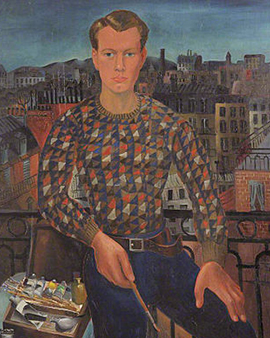The art of the beginning of the 20th century belongs to the classical modernists. Vincent van Gogh and Paul Gauguin had paved the way for new impulses in art. Modern painting broke away from traditional painting and offered artists the great freedom of their own expression. In France the art form of Surrealism developed and a touch of the Avant-garde permeated England's galleries. Dadaism, Cubism and Fauvism were art movements that influenced painting as much as literature. The artists had the great opportunity to experiment in many directions. Painting had freed itself from all set limits. Successful were those artists who were able to secure the favour of a collector and received financial support from patrons. If the life of the bohemian had always been an antipole to the social norm, a life in intoxication developed in the artist scene.
Christopher Wood was born into one of the most dazzling artistic epochs that Europe has experienced to date. Wood has great talent, but at a young age the artist lacks his own style. The painter had not yet found himself when he was caught up in the lively maelstrom of painters and art collectors. He tried surrealism, tried primitivism, and finally joined a London art group that returned to the classical conversations of art. Important stations of his development are Paris, London and St. Ives. Time and again, Wood succeeded in creating paintings with which he caused a great stir in the art scene. The Fisherman's Farewell shows a moment on the beach in Cornwall, which Wood depicts in the "primitive" style he so appreciates as an artist.
Christopher Wood does not succeed in drawing the quintessence from his successes. The life of the painter is determined by incredibly successful exhibitions and sad failures. The sine curve in Wood's artistic career is accompanied by private events. Neither love for women nor for men leads to a stable partnership. Opium was considered in artist circles to be an adequate means of luring creativity out. In combination with alcohol, quite a few painters lived through their days in a frenzy. The artist Christopher Wood suffered from paranoia and confusion in his last creative years. In Brittany, the English painter found motifs for which the art scene adored him. Renoir had already captured the flair of the coastal town of Treboul. Wood gave the landscape a naive expression. At the end of 1930 the painter created his last works. Zebra and Parachute shows a clear proximity to Surrealism. The painter ended his life in the same year. There are speculations about the reasons. Drugs or the fear of criticism could have been the trigger for the desire to stop living.
×





.jpg)
.jpg)
 - (MeisterDrucke-176024).jpg)
 - (MeisterDrucke-176024).jpg)
.jpg)
.jpg)
.jpg)
.jpg)
.jpg)
.jpg)
 - (MeisterDrucke-235679).jpg)
 - (MeisterDrucke-235679).jpg)
.jpg)
.jpg)
.jpg)
.jpg)
.jpg)
.jpg)
_-_(MeisterDrucke-909877).jpg)
_-_(MeisterDrucke-909877).jpg)
.jpg)
.jpg)
.jpg)
.jpg)
.jpg)
.jpg)
.jpg)
.jpg)
.jpg)
.jpg)
.jpg)
.jpg)
_-_(MeisterDrucke-556955).jpg)
_-_(MeisterDrucke-556955).jpg)
.jpg)
.jpg)
.jpg)
.jpg)
.jpg)
.jpg)
.jpg)
.jpg)
.jpg)
.jpg)
_dans_des_pots_Peinture_de_Christopher_Wood_(19_-_(MeisterDrucke-1639847).jpg)
_dans_des_pots_Peinture_de_Christopher_Wood_(19_-_(MeisterDrucke-1639847).jpg)
.jpg)
.jpg)
.jpg)
.jpg)
.jpg)
.jpg)
.jpg)
.jpg)
.jpg)
.jpg)
.jpg)
.jpg)
.jpg)
.jpg)
_-_(MeisterDrucke-1106220).jpg)
_-_(MeisterDrucke-1106220).jpg)
_-_(MeisterDrucke-900365).jpg)
_-_(MeisterDrucke-900365).jpg)
_-_(MeisterDrucke-901911).jpg)
_-_(MeisterDrucke-901911).jpg)
.jpg)
.jpg)
.jpg)
.jpg)
.jpg)
.jpg)
.jpg)
.jpg)
.jpg)
.jpg)
_-_(MeisterDrucke-890871).jpg)
_-_(MeisterDrucke-890871).jpg)
.jpg)
.jpg)
.jpg)
.jpg)
.jpg)
.jpg)
.jpg)
.jpg)
.jpg)
.jpg)
_-_(MeisterDrucke-910209).jpg)
_-_(MeisterDrucke-910209).jpg)
.jpg)
.jpg)
 - (MeisterDrucke-154515).jpg)
 - (MeisterDrucke-154515).jpg)
.jpg)
.jpg)
.jpg)
.jpg)
_-_(MeisterDrucke-911005).jpg)
_-_(MeisterDrucke-911005).jpg)
.jpg)
.jpg)
.jpg)
.jpg)
.jpg)
.jpg)
_1928_-_(MeisterDrucke-559353).jpg)
_1928_-_(MeisterDrucke-559353).jpg)
.jpg)
.jpg)
_-_(MeisterDrucke-551640).jpg)
_-_(MeisterDrucke-551640).jpg)
.jpg)
.jpg)
 - (MeisterDrucke-74685).jpg)
 - (MeisterDrucke-74685).jpg)
.jpg)
.jpg)
 - (MeisterDrucke-62679).jpg)
 - (MeisterDrucke-62679).jpg)
.jpg)
.jpg)
.jpg)
.jpg)
.jpg)
.jpg)
.jpg)
.jpg)
.jpg)
.jpg)
.jpg)
.jpg)
.jpg)
.jpg)
.jpg)
.jpg)
.jpg)
.jpg)
 - (MeisterDrucke-78047).jpg)
 - (MeisterDrucke-78047).jpg)
.jpg)
.jpg)
.jpg)
.jpg)
.jpg)
.jpg)
.jpg)
.jpg)
.jpg)
.jpg)
.jpg)
.jpg)
.jpg)
.jpg)
.jpg)
.jpg)
.jpg)
.jpg)
.jpg)
.jpg)
.jpg)
.jpg)
.jpg)
.jpg)
.jpg)
.jpg)
_Painting_by_Christopher_Wood_(_-_(MeisterDrucke-1024479).jpg)
_Painting_by_Christopher_Wood_(_-_(MeisterDrucke-1024479).jpg)
.jpg)
.jpg)
_-_(MeisterDrucke-911308).jpg)
_-_(MeisterDrucke-911308).jpg)
.jpg)
.jpg)
_-_(MeisterDrucke-1131352).jpg)
_-_(MeisterDrucke-1131352).jpg)
.jpg)
.jpg)
.jpg)
.jpg)
.jpg)
.jpg)
_-_(MeisterDrucke-1175062).jpg)
_-_(MeisterDrucke-1175062).jpg)
.jpg)
.jpg)
.jpg)
.jpg)






